ISSN ONLINE(2319-8753)PRINT(2347-6710)
ISSN ONLINE(2319-8753)PRINT(2347-6710)
|
Dr.Rajanna.S Associate Professor, Dept. of Mechanical Engineering, GEC, Kushalnagar, India |
| Related article at Pubmed, Scholar Google |
Visit for more related articles at International Journal of Innovative Research in Science, Engineering and Technology
This basic information on welded rail steel is very much essential to ensure the quality of weld. Thermite welding is mainly used in world. The reasons why the thermite welding method is widely used are that the equipment has good mobility and total working time of that is shorter than that of the enclosed arc welding method on site. Moreover, the operating skill, which required for thermite welding, is less than that of for enclosed arc welding. In the present research work,heat treatment’ technique was used improve the mechanical properties and weldment structure. The specimens were cut in the transverse direction from As thermite welded and Heat treated Thermite Welded rails. Specimens were prepared according to AWS standard and subjected to tensile test, Impact test and hardness and their results were tabulated. Microstructural analysis was carried out with the help of SEM. Then analyze to effect of heat treatement on Mechanical properties of their thermite welded rails. Compare the mechanical and microstructural properties of thermite welded rails with heat treated thermite welded rails.. Mechanical and microstructural response of heat treated thermite welded rail is higher value as compared toAs thermite welded rail.
Keywords |
| Structure, Thermite, Strength, Response, Rails. |
INTRODUCTION |
| Most modern railways use continuous welded rail (CWR); in this form of track, the rails are welded together by utilizing the thermite reaction to form one continuous rail that may be several kilometers long. Because there are few joints, this form of track is very strong, gives a smooth ride, and needs less maintenance. Welded track has become common on main lines since the 1950s. Continuous Welded Rail is shown in Fig. 1. Because of its strength, trains traveling on welded track can travel at higher speeds and with less friction. Welded rails are more expensive to lay than joined tracks, but are significantly cheaper to maintain. As mentioned earlier, rails expand in hot weather and shrink in cold weather. Because welded track has very few expansion joints, if no special measures are taken, it could become distorted in hot weather and cause a derailment. To avoid this, welded rails are very often laid on concrete steel sleepers, which are so heavy they hold the rails firmly in place, and with plenty of ballast to stop the sleepers moving. After new segments of rail are laid, or defective rails replaced (welded in), the rails are artificially stressed. The stressing process, involves either heating the rails causing them to expand, or stretching the rails with hydraulic equipment. They are then fastened (clipped) to the sleeper in their expanded form. This process ensures that the rail will not expand much further in subsequent hot weather. In cold weather the rails try to contract, but because they are firmly fastened, cannot do so. In effect, stressed rails are bit like a piece of stretched elastic firmly fastened down. Engineers try to heat the rail to a temperature roughly mid way between the average extremes of hot and cold (this is known as ‘rail neutral temperature’). If temperatures reach outside normal ranges however, welded rails can buckle in hotter than usual summer or can actually break in a colder than anticipated winter. Joints are used in continuously welded rails when necessary; instead of a joint that passes straight across the rail, producing a loud noise and shock when the wheels are pass over it, two sections of rails are cut at a steep angle and put together with a gap between them (a breather switch). |
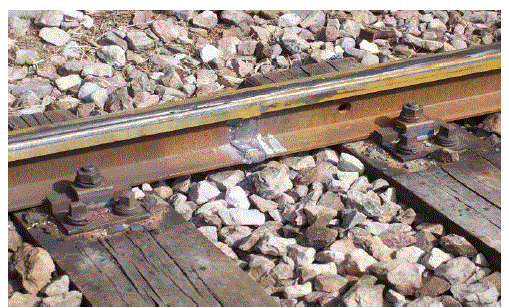 |
EXPERIMENTAL PROCEDURE |
| A. Material |
| The material used in the study was 52 kg/m rail steel widely used as a rail road track in Indian Railway and selected as starting material in the research work. The chemical composition of the rail steel [1] was ascertained with the help of Baird emission spectrometer (Model: DV4), Leco carbon-sulphur determinator (Model: CS244) and the chemical composition were summarized in Table 1. |
 |
| The percentage of carbon gives hardness to the rail steel and also accelerate in cementite formation in the rail steel. Manganese gives ductility to the rail and accelerates in ferrite formation in the rail steel. The above values of chemical composition found above the minimum requirement of the rail steel. The above mentioned chemical elements greatly influenced on formation of ferrite and cementite. |
| B.Thermite welding of rail steel |
| In the present research work thermite welding is the method employed in welding of rails. The rails were cut square and the gap to be welded. (If the rail ends are cut skewed, the gap will be non-uniform and the fusion of the rails will be asymmetric.).The cut faces were cleaned with kerosene oil and a wire brush to remove rust, dust, or greasy material, etc. (Otherwise, this material may get fused with the weld material and this may render the weld defective.) long steel straightedge was used to align the running edge of the rail head. A set of prefabricated moulds of the broad gauge rail section was selected and examined for suitability. The rail profile of the mould was checked by placing the mould against the side of the rail to be welded. The moulds were placed in the mould shoe. The placement of the mould made on central over the gap (otherwise while pouring the molten metal, one rail end will get more heat than the other and the fusion of the metal at the other rail end may not be complete) Small adjustments were made on mould profile by rubbing the mould gently against the sides of the rail. A slag bowl was attached to the mould shoe to collect the overflowing slag and molten metal during pouring. The Thermite welding furnace is shown in Fig.2. |
| During welding, utilized the composition of 5 parts iron oxide powder and 3 parts aluminum powder ignited at high temperature in crucible and reaction between fine aluminum and iron oxide powders were made and produced a red hot iron and aluminium oxide. The reaction between Aluminium and Iron oxide are mentioned below: |
| Fe2O3 + 2Al = 2Fe + Al2O3 + 181.5 kcal |
| 3Fe3O4 + 8Al =9Fe + 4Al2O3 + 719.3 kcal |
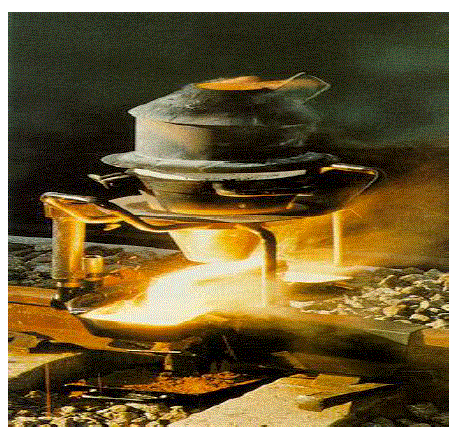 |
| After completion of exothermic reaction aluminium oxide floated on top surface of the crucible, about 20 to 25 seconds were taken for separation of slag from molten steel. Stands for crucible and torch were fixed on the railhead Welding torch lit and the flame was tuned. This torch was placed in its stand which was fixed over the gap, and the flame directed into the mould through the central opening. The flame heats the rail ends and this was done for each rail section (Pre-heating the rail ends (to about 1000 °C) required to help the poured molten metal in washing away the surface oxidation on the rail ends, as otherwise, the molten metal may chill and solidify immediately on coming in contact with cold rail ends, without washing off the surface oxidation).The crucible housed at 1 meter height and alignment was made on the swiveling crucible stand. A closing pin was placed at the bottom over the opening. The crucible was swung away from the rail and the 'portion' (self-igniting mixture which yields the molten metal) poured into the crucible, heaped in a conical shape. As the preheating is completed, the Thermite reaction was initiated by igniting a sparkler and putting it into the crucible. The reaction allowed and the slag gets separated from the molten metal. Thereafter, the closing pin tapped from the outside, thus discharging the metal was made into the top central cavity of the mould. On completion of pouring, The molten metal in the mould allowed to cool for a period of 5 seconds. After crucible lifted off and slag bowls removed from the mould shoes and also the crucible and torch stands were removed. After welding weldments were subjected to ultrasonic examination to ensure the soundness of welded joint of the rail. The joint is then finally ground to exact profile it is checked for straightness and is brought within the desired tolerance |
| C. As Thermite welded Rail |
| The above procedure produced joint called as thermite welded rail. From this tensile, Impact, Hardness specimen were prepared as per AWS standard and subjected to respective tests. |
| D. Heat treated thermite welded rail |
| Thermite welded Rails of ultrasonic tested subjected to the heat treatment involved annealing was carried out at 820 0C for 45 minutes [3]using muffle furnace capacity of 1400 amps and specimen taken out and cooling to room temperature using normalized condition. From this tensile specimen, Impact, Hardness specimen were prepared as per AWS Standard. |
RESULT AND DISCUSSION |
| The results of the studies carried out in the area of Mechanical and Microstructural properties of the welded rails and have been presented and discussed under the following headings. |
| A.Tensile Test of Thermite welded Rail Steel |
| The Tensile test results of Thermite welded Rail Steel is tabulated in Table 2. |
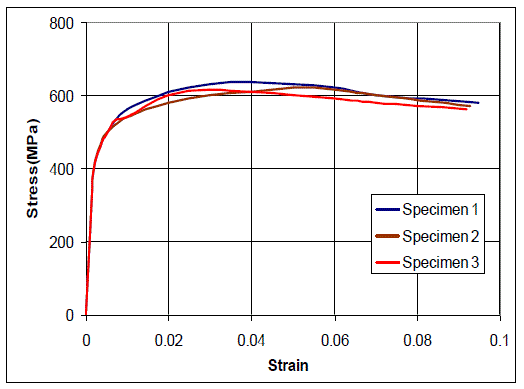 |
| B. Tensile Test of Heat treated Thermite Welded Rail Steel |
| The Tensile test results of heat treated thermite welded Rail Steel is tabulated in Table3 |
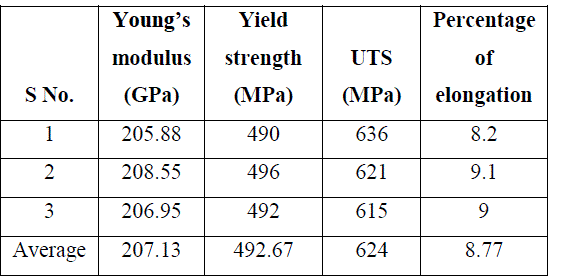 |
| The mechanical properties in thermite welded rails have been improved by adapting heat treatment process as mentioned below. |
| Condition 1 As Thermite welded rail |
| Condition 2 Thermite welded rail with heat treatment. |
| As mentioned above two conditions tests were conducted at ambient temperature. The room temperature mechanical properties of yield strength, Ultimate tensile strength and ductility mentioned in Table 2 and 3 for two different conditions of thermite welded rail. The stress is calculated based on the original cross sectional area before testing. There is an increase in ultimate tensile strength, yield strength and elongation as compared to condition thermite welded rail. The result of present work shows that heat treatment improves the ultimate tensile strength and elongation. In heat treatment causes the replacement of very coarse ferritic-pearlitic structure by much finer structure very thin cementite lamellae appears in the pearlite were as the fine ferrite network on the grain boundaries indicates the size of the prior austenite grains from which the fine ferritic pearlitic structure has evolved. And also changes from brittle to ductile nature.In As Thermite welded rail condition, the failure occurred after a small plastic deformation preceding the rupture. Fracture surface indicates the cleavage [2] and causes brittle fracture. From the above result found that significant improvement like ultimate tensile strength, yield strength, percentage of elongation have been made in heat treated thermite welded rails. |
| C. Impact Test |
| The Impact Energy of Thermite weld, Thermite weld with Heat treatment is tabulated in Table 4. |
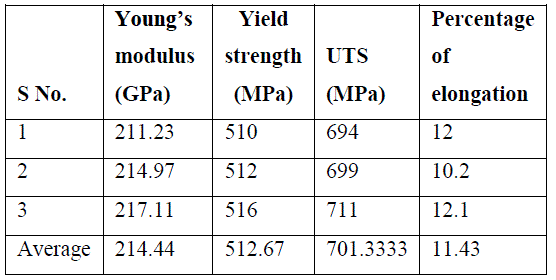 |
| Impact results of thermite welded rails with heat treatment conditions shows improvement in toughness value as compared to As Thermite welds because of ductility improvement in weldment by using heat treatment. Residual stresses are minimized using heat treatment hence heat treatment gives better impact strength. |
| D. Brinell hardness profile |
| The Comparison of Brinell hardness number of Thermite weld and Thermite weld with Heat treatment is shown in Fig5 |
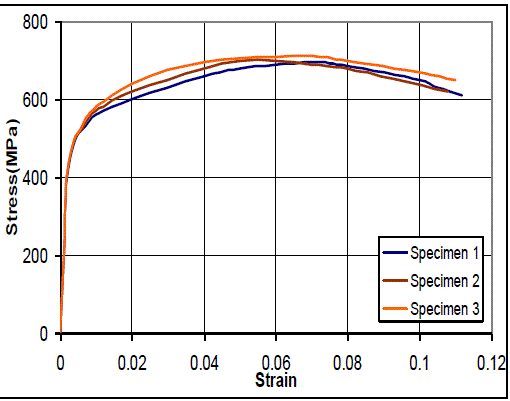 |
| In thermite welded rail of two conditions shows non symmetric hardness traverses along longitudinal direction of weldment. In the heat treated thermite welded rail there is a significance difference in hardness between the base metal and heat affected zone (285+/- 15 BHN) on one hand and the weld metal on the other hand (230+/- 10 BHN). Totally hardness at weldment is lower than as compared thermite welded rail. this could indicate that faster wear will occur on the weldmetal however this prediction may be premature if one bears in mind the finner ferritic-pearlitic structure. Two conditions shows non symmetric hardness along the longitudinal direction because of functionally graded cast structure. This non symmetric hardness profile mainly due to non uniform cooling rate during solidification of weld metal. As thermite welded hardness profile, shows that hardness is minimum in the weldmetal as well as hardness is maximum in the heat affected zone close to the base metal. Totally hardness of weld is slightly higher than the base material. |
| E.Microstructure. |
| Microstructure of As Thermite Weld |
| Microstructure of thermite welded rail exhibits very coarse grained ferritic-pearlitic structure and cast structure and also presence of nitride, sulphide or carbide precipitates along the ferrite boundary. Aluminium oxide and secondary inclusions [4]which found at grain boundaries of ferrite. The Microstructure of As Thermite Weld is shown in Fig.6. |
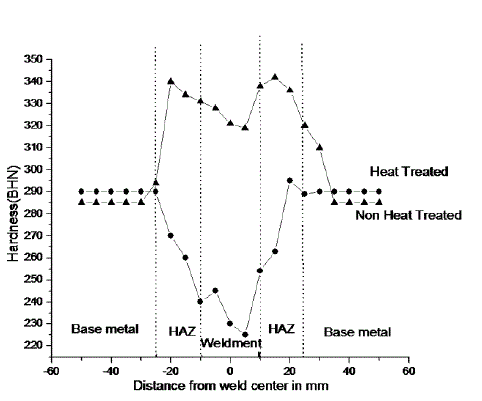 |
| Microstructure of Heat treated Thermite Weld rail |
| Microstructure of Heat treated thermite welded rail causes the replacement of very coarse ferritic-pearlitic structure by a much finer structure very thin cementite lamellae appears in the pearlite, where as the fine ferrite network on the grain boundaries indicates the size of the prior austenite grains from which the fine ferritic pearlitic structure has evolved. Structure of fine ferritic-pearlitic mainly depends on heat treatment temperature[5]. The Microstructure of Heat treated thermite welded rail is shown in Fig.7. |
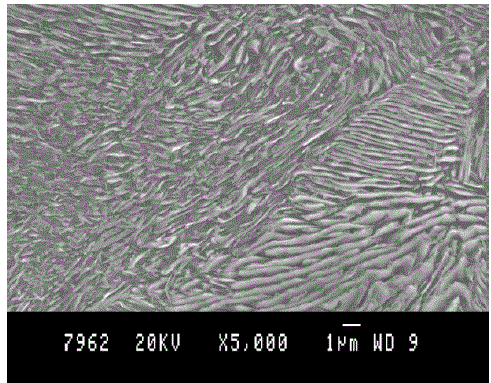 |
CONCLUSION |
| All welded tensile specimen of thermite welded rail have failed in weldment region with significant variation in strength due to residual stresses developed due to high temperature ingredient. In case of thermite welded SEM shows that Ferritic-Pearlitic structure and consists of aluminium oxide inclusions formed in the interdendritic space. Thermite welded rails exhibits low ductility and toughness due to the presence of carbide precipitate along the ferrite boundary. All mechanical properties of thermite welded rails is lower due to reaction between the welded metal and magnasite reduces the quality of the welded joints. In thermite welding quality of weldment has been improved using heat treatment. Heat treated thermite welded rail condition shows improvement in all mechanical properties as compared to As thermite welded rails due to minimize the residual stress in Weldment |
References |
|